There is a very simple method for trading coins that allows you to maintain "consistent profits," achieving 30 million!
At the end of last year, I played with 200,000, and now it has turned into 20 million, achieving a hundredfold profit (suitable for everyone). This method continues to work.
I am still using it, and it is very stable.
You do not need to worry about whether you can learn. I can seize this opportunity, and you can too. I am not a god, just an ordinary person. The difference between others and me is that they ignore this method. If you can learn this method and value it in your future trading, it can help you earn at least 3 to 10 points daily.
First step: Add coins that have increased within 11 days to the watchlist. However, it is important to note that coins that have fallen for more than three days should be excluded to avoid losing profits.
Step 2: Open the candlestick chart and only look at the coins with a monthly MACD golden cross.
Step 3: Open the daily candlestick chart, look only at a single 60 moving average. As soon as the coin price retraces to the vicinity of the 60 moving average and shows a volume K-line, enter heavily.
Step 4: After entering the market, use the 60 moving average as the standard; if it is above the line, hold; if it is below the line, exit and sell. This is divided into three details.
1: When the price increase exceeds 30%, sell one-third.
2: When the price increase exceeds 50%, sell one-third.
3: This is the most important and core factor that determines whether you can profit. If you buy in one day, and the next day due to unexpected circumstances, the coin price directly breaks below the 60-day moving average, you must exit entirely without any sense of luck. Although the probability of breaking below the 60-day line is very low with this method of selecting coins by combining monthly and daily lines, we still need to have a risk awareness. In the crypto circle, preserving your capital is the most important thing. Even if you've already sold, you can wait to buy back when it meets the buying conditions again. Ultimately, the difficulty in making money lies not in the method but in execution. "When the coin price directly breaks below the 60-day moving average, you must exit entirely without any sense of luck." This one sentence has killed 90% of people.
Everyone comes to the crypto circle with the same intention; this is beyond doubt. If you are just here to play around and pass the time, then this is not suitable for you.
Here is a list I have compiled of all the sectors and leading coins in the blockchain that you need to know before entering the crypto circle, covering mainstream coins and altcoins, to save you time in sorting them out. You can double-click to save it!
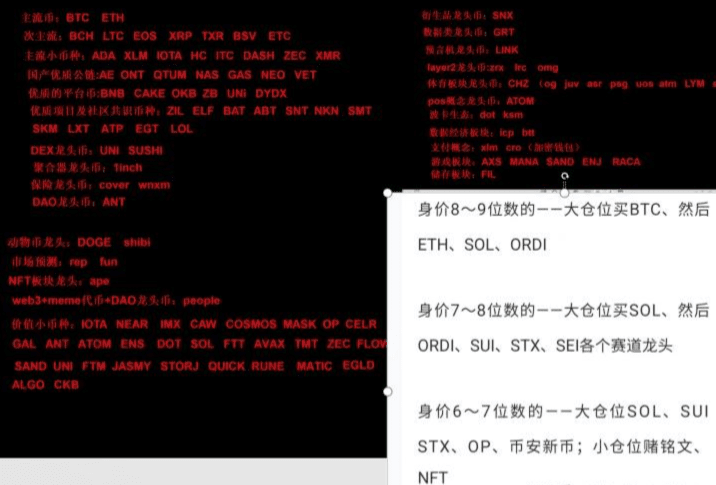
Achieving financial freedom, mastering the secrets of wealth, and making a class leap is possible because I have realized and summarized the following small tips for trading coins, shared with those destined to find them, and worth saving!
When investing in cryptocurrencies, a few small tricks can help you find potential coins and achieve good investment returns.
1. Find potential coins.
1. Look for coins that have increased by over 100% in the past two months.
Some coins will show obvious signs before they start to rise. We can liken it to real-life situations: excellent people usually perform well in the past, while unreliable people may do something foolish. When choosing investments, put recently strong-performing coins on your watchlist.
In specific operations, I prefer coins with steady increases. This is somewhat like choosing good-looking people; everyone is excellent, and we will see who performs better.
2. Focus on coins that have reached historical highs and have been listed for more than six months.
Do not be afraid of missing out just because the coin price has risen. Any coin that can multiply tenfold starts from doubling. Bullish coins usually first hit a historical high, which is not blind following.
2. Patiently wait for mid-term adjustments.
Waiting for mid-term adjustments is very important. What is a mid-term adjustment? It is a process that must undergo at least two months of fluctuations or corrections.
Why wait so long? Because it is necessary to let the overly excited funds in the market cool down and allow investors with significant profits to change hands, thereby stabilizing the market. This strategy helps to consolidate the thoughts and strength of investors.
The first wave of particularly strong coins can be slightly shorter, requiring only a two-week adjustment. A particularly strong indicator is when the coin price doubles within two months. 3. The resonance of indices and sectors.
Waiting for a mid-term adjustment to meet the requirements does not mean buying immediately. You must patiently wait for the overall market and specific sectors to resonate, and then enter the market based on the following signals:
1. A significant mid to long bullish line starts with increased volume.
2. Narrow fluctuations with reduced volume. There's no need to wait for the coin price to exceed the previous high point after the adjustment. Because exceeding it again doesn't necessarily mean success; entering at the starting point is more advantageous.
The above methods can help you find potential coins in the market and invest at the right time, increasing the chances of investment success.
As someone who has been trading coins for over a decade, starting from 8000 to make 10 million, then going into debt of 8 million, then making 20 million, and now achieving financial freedom, in the last two years, from May 23, 2022, to June 4, 2024, I achieved a return rate of 418134.86% with less than 700,000, bringing my wealth to over 28 million. I want to give practical and useful advice to those just entering the crypto circle.
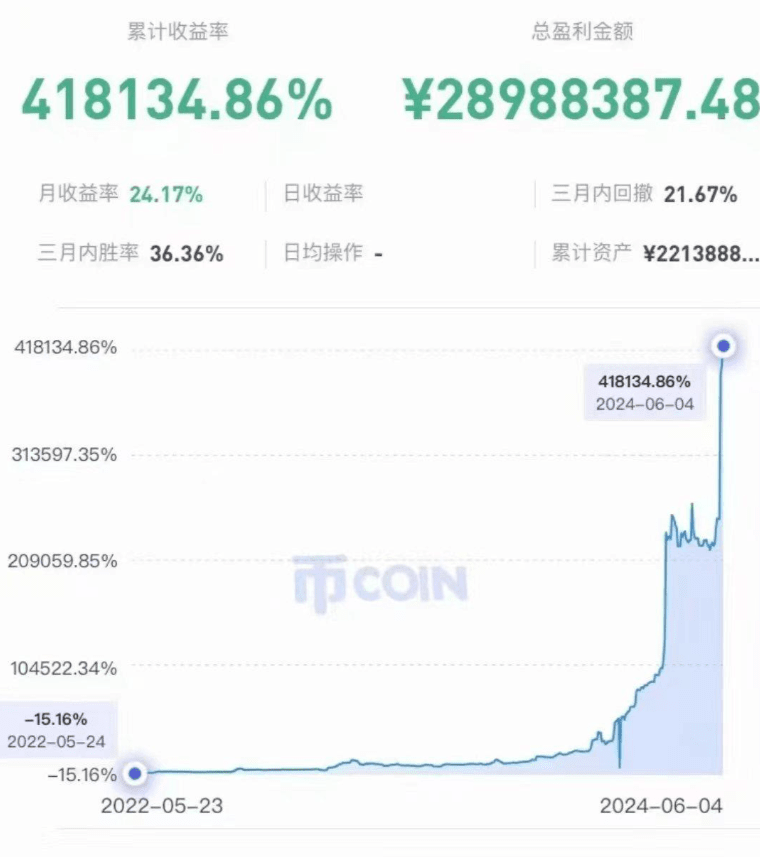
Achieving financial freedom in the crypto circle is because I have mastered the following secrets: I have organized and shared them with those destined to find them.
Secret 1: Moving Average Secrets! The 'Gann's Eight Major Rules' will help you accurately capture buy and sell points.
Secret 2: The winning weapon in the crypto circle: Accurately mastering the four rules for golden sell points is essential for stable profits in the market!
Secret 1: Moving Average Secrets! The 'Gann's Eight Major Rules' will help you accurately capture buy and sell points.
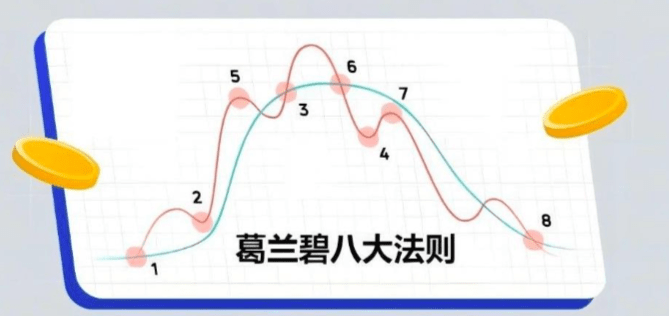
Price fluctuations have certain patterns, and moving averages represent the direction of trends. Therefore, when price fluctuations deviate from trends, i.e., "the deviation between price and moving averages," it is likely to correct towards the trend direction in the future. Thus, deviations are significant buy and sell signals.
We refer to the divergence between price and moving averages as Bias, defined as Bias = Price - MA, where Price is the price; MA is the moving average. The greater the divergence, the higher the possibility of price correction. However, on the other hand, if the trend is accelerating, it can also be expected that future divergence will widen. Therefore, divergence is also an observation indicator.
Gann's Eight Major Rules use the relationship between price (coin price, futures price, or exchange rate) and moving averages as the basis for buy and sell signals. The main strategies include support, resistance, breakouts, divergence, and false breakouts. Through these signals, investors can gain references during operations.
Gann believes that the volatility of coin prices has a certain pattern, and moving averages represent the direction of the trend. Gann's Eight Major Rules summarize eight different situations as the basis for entering and exiting the market.
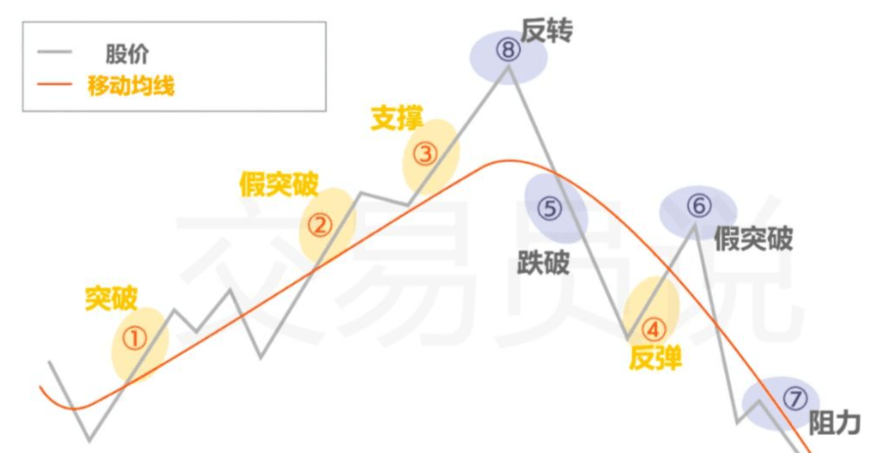
① Breakout: When the moving average turns from a downward trend to horizontal consolidation or upward, and the stock price breaks through from below the moving average, it can be seen as a buy signal.
② False breakout: The stock price breaks below the moving average but immediately rebounds above it, and the moving average is still showing an upward trend, which can be seen as a buy signal.
③ Support: When the stock price trend is above the moving average, even if the price corrects downwards but does not break below the moving average, it rebounds again, which can be seen as a buy signal.
④ Rebound: When the stock price sharply falls and not only breaks below the moving average but also deviates significantly below it, and the price starts to rebound towards the moving average, it can be seen as a buy signal.
⑤ Break below: When the moving average turns from an upward trend to a horizontal line or shows a downward trend, and the stock price breaks below the moving average from above, it can be seen as a sell signal.
⑥ False breakout: When the stock price rebounds and breaks through the moving average, but then immediately reverses and falls below the moving average, and the moving average is still in a downward trend, it can be seen as a sell signal.
⑦ Resistance (overhead pressure): When the stock price trend continues below the moving average, even if the price rebounds, it cannot break through the moving average. At this time, the moving average becomes a resistance level for the stock price and can be seen as a sell signal.
⑧ Reversal: When the stock price sharply rises and significantly deviates above the moving average, then reverses and falls back towards the moving average, it can be seen as a sell signal.
◔ The four core spirits of Gann's Eight Major Rules.
1. Do not short when the moving average is rising; do not go long when the moving average is falling.
2. Moving averages themselves have characteristics of support and resistance, which are beneficial for assessing bullish and bearish conditions.
3. The bullish and bearish arrangements of prices are a combination pattern of price and moving averages. Once the arrangement trend reverses, it is necessary to change strategies and operate in the opposite direction.
4. The golden cross and death cross of moving averages are points where past price costs intersect; once an intersection occurs, it often leads to price forming an upward or downward trend and provides opportunities for trend-following operations.
◔ The four major application defects of Gann's Eight Major Rules.
1. The Gann theory highly relies on moving average operations, and since the moving average reflects the historical trajectory of prices, the occurrence of signals often lags behind the price, creating a time gap.
2. When prices are in a consolidation trend, false signals often occur.
3. When choosing shorter period moving averages, such as the 5-day or 10-day, the time lag of signals will decrease, but there will be more false signals.
4. When choosing a longer period moving average, such as the 120-day or 200-day, the signals obtained will be significantly effective, but there will be a time lag. For example, buy and sell signals may only appear after the price has already risen or fallen a little.
◔ Gann's Eight Major Rules Parameter Settings.
As mentioned earlier, using shorter period moving averages (such as the 10-day line) reacts more sensitively to price changes compared to longer period moving averages. Conversely, the changes in longer period moving averages tend to be slower and more stable. Therefore, when the stock price simultaneously breaks through both long and short period moving averages, it can be viewed as a short-term reversal buy signal, prompting a buying action. If the price falls below the short period moving average, it can be seen as a short-term reversal sell signal, and short-term traders may even consider short selling.
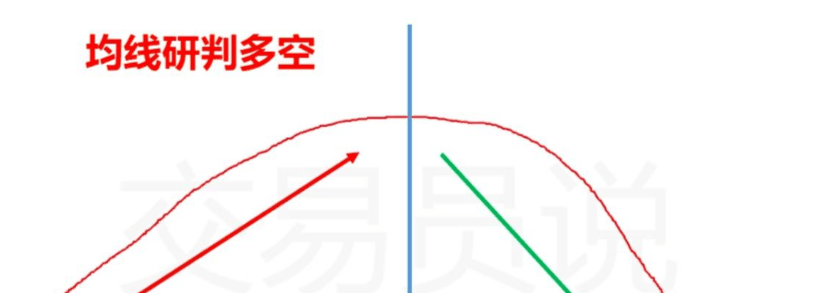
Thus, the choice of moving average periods is quite important. Some may ask: which parameter is the best! This is a very good question, as it is a question every trader is seeking the answer to.
Here’s a standard answer: There are no best or most accurate period parameters, only the ones that suit you best.
Some traders may be short-term traders, so the period parameters of the moving averages do not need to be set too long to respond to the rapid fluctuations required for short-term trading. Alternatively, if a trader is a swing trader, the period parameters of the moving averages do not need to be set too short, which is used to judge the medium-term trend of price movements.
Find the moving average periods that match the product you are trading, in line with your operating logic and habits, to ensure the reliability and stability of buy and sell signals.
Before traders start using the Eight Major Rules for buy and sell signal entries, they should first ensure they have a considerable degree of confidence in the accuracy and success rates derived from various products and time periods to apply them more effectively.
Summary.
Gann's Eight Major Rules define the parameters of moving averages differently. Short-term trades can use a 10MA as a parameter, while medium to long-term trades can use 22MA, 65MA as parameters. The moving average essentially represents the average cost of price holders. Gann's Eight Major Rules summarize the relationship between price and the costs held by most people, using changes within this relationship as the basis for trading.
Secret 2: The winning weapon in the crypto circle: Accurately mastering the four rules for golden sell points is essential for stable profits in the market!
The instructor shares with everyone: my winning weapon in the crypto circle: accurately mastering golden sell points is essential for stable profits in the market!
The longer the horizontal movement, the higher the vertical movement! Knowing how to buy is not a skill; knowing how to sell is the true mastery!
Four Rules for Golden Sell Points.
① Volume-price divergence method: Sell on a spike with low volume! In simple terms, after the first wave of rising, the second and third waves start to see reduced volume; each wave is smaller than the last.
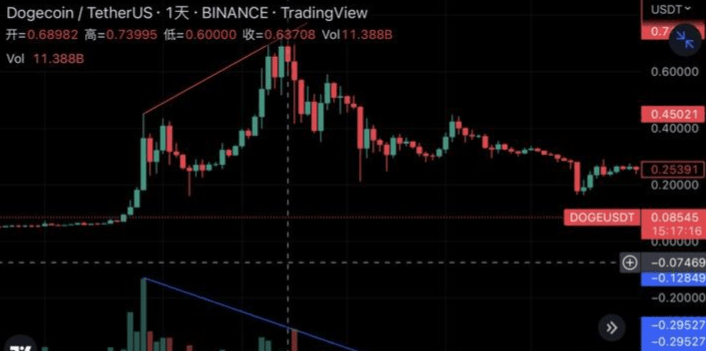
Dogecoin reached an all-time high of 0.73 on May 8, 2021. From the above chart, we can see that the first spike was accompanied by high volume, while the second time it reached a new high, the volume was reduced. Musk was already quietly unloading, while the retail investors were still foolishly waiting for a push to $1. This set-up has trapped millions of investors, and it has been a continuous decline for a whole year.
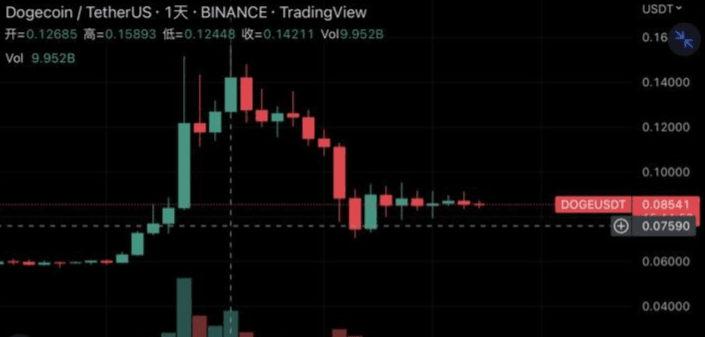
This wave of rise in November 2022 is similar to the last one and may become the last chance to exit during the bear market.
② Moving stop-loss method: sell when breaking below the platform's low point!
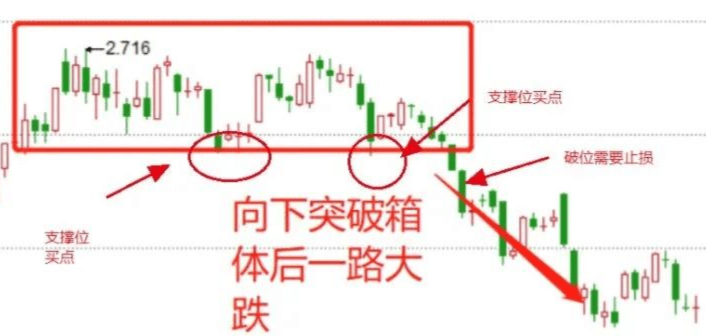
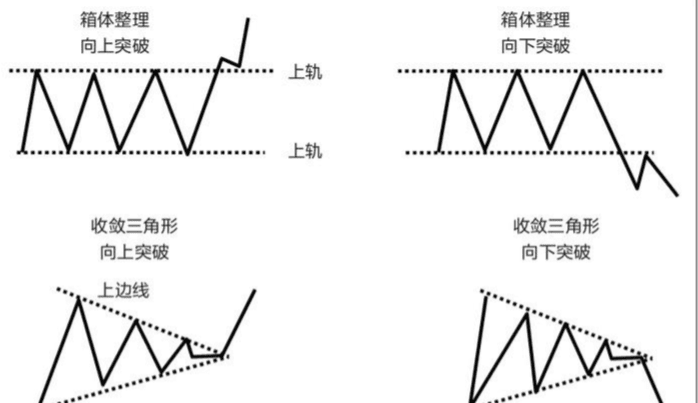
In an upward trend, once the price breaks below the lower edge of the first platform, second platform, and third platform, sell. The lower edge support level is often accompanied by multiple wicks because there are strong hands supporting it. Once there is no one to support, the market is likely to turn downwards.
③ Sell based on moving averages: When the coin price remains below the moving average for a long time, sell. If it slightly breaks below the moving average but does not continue to fall and instead quickly recovers, it indicates that there are likely strong hands supporting the price. Conversely, if there is a surge followed by a long period below the moving average, the coin is likely abandoned by strong hands.
④ When the coin price rebounds weakly and does not exceed the moving average, sell. This is often used in M tops, head and shoulders tops, and triple tops. The last rebound is the final opportunity to sell. When the rebound is weak and the volume dwindles, a significant drop is about to come.
Finally, Mu Qing shares a summary of 20 Bitcoin trading investment tips with everyone.
In any investment market, basic investment strategies are consistent. However, for complex and variable markets, mastering general investment strategies is necessary, but on this basis, investors must also learn and master certain practical skills. Some investment techniques that have been tested through extensive practice not only carry philosophical meaning but also have strong guidance in practical operations. I hope summarizing 20 investment tips can help you in your investment journey.
1. Invest with "idle money."
Remember, the money used for investment must be "idle money," meaning funds that do not have urgent or specific uses in the short term. If investors use essential living expenses for investment and incur losses, it will directly affect their family's livelihood. Alternatively, if they use money that should not be invested, they will psychologically be at a disadvantage, making it difficult to maintain an objective and calm attitude during decision-making, thus increasing the chances of failure in the investment market.
2. Know yourself for success.
Knowing oneself and the enemy ensures victory in a hundred battles. However, in the crypto market, knowing oneself is paramount. Investors need to understand their own personalities, as those prone to impulsivity or emotional tendencies are not suitable for this investment. Successful investors mostly control their emotions and maintain rigorous discipline, effectively restraining themselves. Therefore, knowing oneself is key to ultimately succeeding in the crypto market.
3. Face the market and abandon illusions.
The market is real; do not let emotions dictate your actions, overly fantasizing about the future or reminiscing about the past. A seasoned trader said: A person full of fantasies, emotional, and very outward is a beautiful and happy person, but not suited to be an investor. A successful investor can separate their emotions, fantasies, and trading.
4. Small investors should not blindly invest.
Successful investors do not blindly follow others' opinions. When everyone is in the same investment position, especially when small investors are also following suit, successful investors will feel dangerous and change their course. Blind following is a fatal psychological weakness for small investors. Once an economic data is released, or a sudden news flash appears, and price charts "break through" in five minutes, they rush into the market. They fear losing money together but worry more if everyone makes money. In a sense, sometimes misreading the market trend or suddenly reversing the situation after entering a position, resulting in getting stuck, is a normal phenomenon; even experts cannot escape this. However, the most foolish behavior in decision-making and subsequent handling often originates from small investor psychology.
5. Do not overtrade.
To become a successful investor, one principle is to always maintain more than 2-3 times your capital to cope with price fluctuations. If your funds are insufficient, you should reduce the number of contracts you hold; otherwise, you may be forced to "cut losses" to free up capital, even if later your judgment proves correct.
6. Once the decision is made, do not rashly change it.
If you have fully considered and analyzed the price and plan for the day, do not easily change your decision due to fluctuations in current prices. Decisions made based on changes in daily prices and market news, unless you are an investment genius with a sudden insight, are generally very risky.
7. Make quick decisions.
When investing in the Bitcoin market, there are many psychological factors that can lead to failure. One common situation is that investors, facing increasingly large losses, often hesitate to make quick decisions even when they know they cannot afford to be overly optimistic, leading them deeper into trouble and increasing their losses. A brave decision must be made when necessary.
8. Do not blindly implement others' opinions.
This is not to advocate for unilateral decision-making. It must be understood that among investors, only you will be responsible for your investment results. When you have grasped the market direction and made a basic decision, do not easily change it due to the influence of others. Sometimes others' opinions may seem reasonable, prompting you to change your mind, but later you may realize your decision was the correct one. Therefore, others' opinions are always just a reference; your own opinion is the key to making buy and sell decisions.
9. When uncertain, take a wait-and-see approach.
Investors do not need to enter the market every day. Novice traders often eagerly buy and sell, but successful investors wait for opportunities. When they enter the market and feel uncertain or confused, they will also take a step back and adopt a wait-and-see attitude.
10. Appropriately halt buying and selling.
Day after day of trading can dull your judgment. A successful investor once said: Whenever I feel my mental state and judgment efficiency drop below 90%, I begin to lose money, and when my state drops below 90%, I start to incur losses. At this point, I put everything aside and take a vacation. A short break from the market can help you reevaluate the market, reevaluate yourself, and clarify the direction of future investments. Remember, after being in the forest for a long time, don't forget the trees.
11. In adversity, take a break from the market.
Investors are often in a state of extreme tension due to personal interests and losses. If they are in profit, there is some satisfaction to comfort them; but if they are in adversity and constantly losing, or making unnecessary mistakes, they must be careful not to let their minds get inflated and lose clarity and calmness. At this time, the best choice is to put everything aside and take a break from the market. When the break ends, the temporary gains and losses have become the past, the inflated mind has calmed down, and the mental burden has been lifted. I believe the efficiency of investment will improve. There is a saying, "A general who does not know how to rest is not a good general." Without understanding rest and recuperation, talking about breaking the enemy and seizing the city is out of the question.
12. Patience is also an investment.
There is a saying in the investment market that "patience is a form of investment," but few investors can achieve this or truly understand its meaning. For those engaged in investment work, it is essential to cultivate good patience and endurance. Patience is often a "multiplier" for investment success, affecting whether the final result is positive or negative. Many investors do not lack analytical ability or investment experience but simply lack patience, leading to premature buying or selling and resulting in unnecessary losses. Therefore, every investor entering the crypto market should recognize that patience is also a form of investment.
13. Let the past price levels go.
"Past price levels" are often a significant psychological barrier that is difficult to overcome. Many investors make incorrect investment judgments due to the influence of past price levels. Generally speaking, after seeing high prices, when the market falls, they feel quite uncomfortable with the new low prices. Even when various analyses indicate that the market will continue to fall, and the investment climate is very poor, investors often will not sell their holdings at these new low levels and may feel that the prices are very "low," leading to a buying impulse, which results in getting stuck after buying. Therefore, investors should remember that "past price levels" should be left behind.
14. Set a stop-loss position and be ready to cut losses.
Establish a stop-loss position (which is the point where you can endure the maximum loss). Once the market reverses and the coin price falls to the stop-loss point, you must be brave enough to cut losses. This is a very important investment skill. Due to the high risk of Bitcoin, to avoid losses from investment mistakes, we should set stop-loss orders for every trade. When the exchange rate falls to a certain pre-set price and is likely to fall further, immediately execute the trade. This way, the losses incurred are limited and within acceptable levels, preventing further losses and total loss. Because even if you cut losses temporarily, the capital is still there; as long as there is still capital, there is no fear of running out of resources.
15. Do not put all your eggs in one basket.
When engaging in contract trading, one must act within their means and never put all their savings or assets in as a huge gamble. Because in such situations, if the market itself is mispredicted, there is a risk of significant losses or even falling into an inextricable situation. A more prudent approach is to implement a "pyramid adding" method, initially investing a portion, and if the market becomes clear and advantageous, then increase the investment. Additionally, it is crucial to prevent the mentality of putting all your chips on the table during adverse market conditions.
16. Do not lose sight of the details for a few points.
In Bitcoin trading, do not blindly pursue round numbers when in profit. In practice, some people set a profit target after establishing a position, such as needing to earn $200 before leaving. They are always waiting for that moment to arrive. After making a profit, sometimes the price is close to the target, and there is a good opportunity to take profit, but they miss the best price waiting for just a few more points to reach their target. Remember, it is not worth it to lose an opportunity to gain a few points.
17. When the situation is not right, pivot and strike back.
Sometimes, trading with the market, but when entering the market is close to the end, be cautious. If a reversal occurs, do not hesitate to pivot and strike back. For example, after buying in a bullish market, if the price fails to develop, and then suddenly drops sharply, do not panic; instead, reflect on it. If you can ascertain that a reversal is happening, cut losses immediately and strike back.
18. Establish positions when breaking through market ranges.
Market ranges refer to situations where price fluctuations are narrow, and buying and selling forces are evenly matched, temporarily in a tug-of-war state. Whether in an upward trend or a downward trend, once the market range ends and breaks through resistance or support levels, the price will break through and surge forward. For experienced investors, this is a good time to enter the market and establish positions. If the market range belongs to a long-term threshold, the positions established when breaking through the range will yield substantial gains.
19. Be cautious of rebounds after significant drops and adjustments after sharp rises.
In the Bitcoin market, rapid rises or declines in price do not behave like a straight line rising or falling. Rapid increases will always adjust, and steep declines will also rebound. The magnitude of adjustments or rebounds is quite complex and not easy to grasp. Therefore, after the exchange rate rises by two or three hundred points or five or six hundred points, extra caution is needed. It is better to observe from the sidelines rather than rashly follow in.
20. Learn to control risks.
The Bitcoin market is a highly risky one, primarily because the variables determining Bitcoin prices are too numerous. Although there are various theories and teachings about Bitcoin volatility, the market's fluctuations often catch investors by surprise. For investors and operators in the Bitcoin market, it is especially important to learn a bit about risk probability. In other words, in Bitcoin investment, it is necessary to fully understand risks and benefits, the probability of winning and losing money, and several major issues of prevention. Without an accurate understanding of risk control, arbitrarily buying and selling Bitcoin will inevitably lead to losses.




